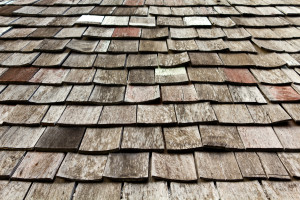 The signs of a damaged roof may start off innocently enough. Maybe some shingle granules gathering at the bottom of your downspouts. Or a few loose shingles falling into your yard after a big storm.
The signs of a damaged roof may start off innocently enough. Maybe some shingle granules gathering at the bottom of your downspouts. Or a few loose shingles falling into your yard after a big storm.
But the real fun starts when the symptoms move inside, as water makes its way through your roof and into the structure itself. Water spots on ceilings, warping moldings and even water running freely down the walls—all are signs that it is time to call the roofer.
Immediately.
But it is always best to have any potential roof damage repaired before these more serious problems appear, so it can be addressed before the damage gets too bad and prevent any further destruction. Not only can a leaky roof damage your ceilings and walls but, left unchecked, can even damage the foundation or lead to persistent mold and mildew issues.
Too often, roof damage is something that homeowners overlook until it is too late. Here’s what to look for:
Exterior: Simply walking around the house and looking for missing or damaged shingles is a good place to start and can quickly identify potential problems. Shingles that appear curled, cracker or torn are likely due for replacement. And don’t forget to inspect the areas around the chimney, ventilation pipes, gutters and flashing. These areas, where the asphalt shingles meet with wood, brick and other materials, can be difficult to seal properly, leading to leaks in an otherwise sound roof.
- Are your shingles curling up at the edges or losing a lot of their granular coating? Are any broken or missing?
- Are your wooden shingles showing signs of mold or decay, or are they splitting?
- Does your flat roof show signs of blistering or wrinkling? This can be a sign that the exterior roof surface has separated from the structure and may be damaged.
- Are the “valleys” of your roof clear and sound? This is often where damage shows up first, and since the valleys are how the roof moves water away from the house missing or damaged shingles in this area can be a major problem.
- Are your gutters rusted or otherwise damaged? Are portions bent or sagging? Gutter problems can trap water against the roof itself and very quickly cause much larger roof problems.
- Is your chimney cracked or broken, and does the flashing around it look to be loose or leaning away from the brick?
Interior: Yes, roof leaks that show up inside the house, but not everything is an active leak. There are some warning signs of roof damage to look for indoors that can be addressed before causing real problems.
- Check the attic. Are any of the rafters noticeably wet or water stained?
- Have your energy bills suddenly increased? There could be a leak in the roof that’s letting air out and contributing to the problem.
- Are there stains on your walls or ceilings? Brown, yellow or gray markings, or peeling paint? All are signs of a developing water leak.
Whatever the case, it is important to remember the roofing work isn’t a DIY job. Even relatively simple upgrades or repairs—installing gutter guards, or replacing lost shingles, for example—need a professional’s eye and experience to ensure that you aren’t introducing new potential problems with your fix. A home’s roof is a system, all pieces working together, day in and day out, to keep your home safe and dry. One weak spot in that system—say, some flashing that was improperly installed—can be enough to ruin the entire roof. A professional roof inspection is always a sound investment.

